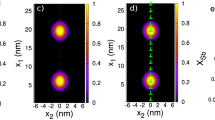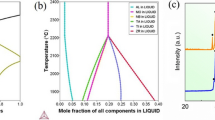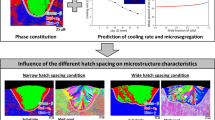Abstract
Al–Nb–B master alloy has been regarded as a promising grain refiner that can reduce grain size of hypoeutectic Al–Si casting alloys. However, its grain refinement performance remains to be improved. In this work, the grain refinement efficacy of Al–Nb–B master alloy is significantly enhanced by modifying the Nb/B ratio through thermodynamic calculation. An Al–Nb–B master alloy with optimum Nb/B ratio of ~ 10:1 provides a fully equiaxed structure across the sections of the Al–10Si and commercial Al–9Si–0.08Ti alloys with an average grain size below 220 μm. The phenomenon is attributed to the existence of NbAl3 and the higher number density of NbB2 at the Nb/B ratio of ~ 10:1, which offers sufficient active nucleating sites to promote the formation of smaller grains. Moreover, the segregation behavior of Si atoms and interfacial energies after doping Si are investigated by first-principles calculations, and the results reveal that Si tends to segregate to the NbAl3/α-Al interface, whereas grain refining potency of NbAl3 for Al remains unchanged. This study has implications for strategic design of Al–Si cast alloy with fine and equiaxed grain structure inoculated by grain refiner.











Similar content being viewed by others
References
Wang K, Jiang HY, Jia YW, Zhou H, Wang QD, Ye B, Ding WJ (2016) Nanoparticle-inhibited growth of primary aluminum in Al–10Si alloys. Acta Mater 103:252–263. https://doi.org/10.1016/j.actamat.2015.10.005
Liao H, Zhang M, Wu Q, Wang H, Sun G (2007) Refinement of eutectic grains by combined addition of strontium and boron in near-eutectic Al–Si alloys. Scr Mater 57:1121–1124. https://doi.org/10.1016/j.scriptamat.2007.08.026
Murty BS, Kori SA, Chakraborty M (2002) Grain refinement of aluminium and its alloys by heterogeneous nucleation and alloying. Int Mater Rev 47:3–29. https://doi.org/10.1179/095066001225001049
Vinod Kumar GS, Murty BS, Chakraborty M (2010) Effect of TiAl3 particles size and distribution on their settling and dissolution behaviour in aluminium. J Mater Sci 45:2921–2929. https://doi.org/10.1007/s10853-010-4284-z
Fan Z, Wang Y, Zhang Y, Qin T, Zhou XR, Thompson GE, Pennycook T, Hashimoto T (2015) Grain refining mechanism in the Al/Al–Ti–B system. Acta Mater 84:292–304. https://doi.org/10.1016/j.actamat.2014.10.055
Yu H, Wang N, Guan R, Tie D, Li Z, An Y, Zhang Y (2018) Evolution of secondary phase particles during deformation of Al–5Ti–1B master alloy and their effect on α-Al grain refinement. J Mater Sci Technol 34:2297–2306. https://doi.org/10.1016/j.jmst.2018.04.018
Qiu D, Taylor JA, Zhang MX, Kelly PM (2007) A mechanism for the poisoning effect of silicon on the grain refinement of Al–Si alloys. Acta Mater 55:1447–1456. https://doi.org/10.1016/j.actamat.2006.09.046
Quested TE, Dinsdale AT, Greer AL (2013) Thermodynamic evidence for a poisoning mechanism in the Al–Si–Ti system. Mater Sci Technol 22:1126–1134. https://doi.org/10.1179/174328406X114234
Li Y, Gu QF, Luo Q, Pang Y, Chen SL, Chou KC, Wang XL, Li Q (2016) Thermodynamic investigation on phase formation in the Al–Si rich region of Al–Si–Ti system. Mater Des 102:78–90. https://doi.org/10.1016/j.matdes.2016.03.144
Banjeri A, Reif W, Feng Q (1994) Metallographic investigation of TiC nucleants in the newly developed Al–Ti–C grain refiner. J Mater Sci 29:1958–1965. https://doi.org/10.1007/BF00351320
Yang H, Gao T, Wang H, Nie J, Liu X (2017) Influence of C/Ti stoichiometry in TiCx on the grain refinement efficiency of Al–Ti–C master alloy. J Mater Sci Technol 33:616–622. https://doi.org/10.1016/j.jmst.2017.04.015
Nie J, Ding H, Wu Y, Liu X (2013) Fabrication of titanium diboride-carbon core-shell structure particles and their application as high-efficiency grain refiners of wrought aluminum alloys. Scr Mater 68:789–792. https://doi.org/10.1016/j.scriptamat.2013.01.026
Birol Y (2009) A novel Al–Ti–B alloy for grain refining Al–Si foundry alloys. J Alloys Compd 486:219–222. https://doi.org/10.1016/j.jallcom.2009.07.064
Dong X, Ji S (2018) Si poisoning and promotion on the microstructure and mechanical properties of Al–Si–Mg cast alloys. J Mater Sci 53:7778–7792. https://doi.org/10.1007/s10853-018-2022-0
Wang T, Chen Z, Fu H, Xu J, Fu Y, Li T (2011) Grain refining potency of Al–B master alloy on pure aluminum. Scr Mater 64:1121–1124. https://doi.org/10.1016/j.scriptamat.2011.03.001
Chen Z, Kang H, Fan G, Li J, Lu Y, Jie J, Zhang Y, Li T, Jian X, Wang T (2016) Grain refinement of hypoeutectic Al–Si alloys with B. Acta Mater 120:168–178. https://doi.org/10.1016/j.actamat.2016.08.045
López VH, Scoles A, Kennedy AR (2003) The thermal stability of TiC particles in an Al7wt.%Si alloy. Mater Sci Eng A 356:316–325. https://doi.org/10.1016/s0921-5093(03)00143-6
Vinod Kumar GS, Murty BS, Chakraborty M (2005) Development of Al–Ti–C grain refiners and study of their grain refining efficiency on Al and Al–7Si alloy. J Alloys Compd 396:143–150. https://doi.org/10.1016/j.jallcom.2004.12.039
Birol Y (2012) Performance of AlTi5B1, AlTi3B3 and AlB3 master alloys in refining grain structure of aluminium foundry alloys. Mater Sci Technol 28:481–486. https://doi.org/10.1179/1743284711y.0000000058
Alamdari HD, Dubé D, Tessier P (2013) Behavior of boron in molten aluminum and its grain refinement mechanism. Metall Mater Trans A 44:388–394. https://doi.org/10.1007/s11661-012-1388-x
Nadendla H, Nowak M (2013) Method of refining metal alloys. USA Patent
Nowak M, Bolzoni L, Babu NH (2015) Grain refinement of Al–Si alloys by Nb–B inoculation. Part I: concept development and effect on binary alloys. Mater Des 66:366–375. https://doi.org/10.1016/j.matdes.2014.08.066
Bolzoni L, Nowak M, Babu NH (2015) Grain refinement of Al–Si alloys by Nb–B inoculation. Part II: application to commercial alloys. Mater Des 66:376–383. https://doi.org/10.1016/j.matdes.2014.08.067
Bolzoni L, Babu NH (2015) Refinement of the grain size of the LM25 alloy (A356) by 96Al–2Nb–2B master alloy. J Mater Process Technol 222:219–223. https://doi.org/10.1016/j.jmatprotec.2015.03.011
Bolzoni L, Nowak M, Babu NH (2015) Assessment of the influence of Al–2Nb–2B master alloy on the grain refinement and properties of LM6 (A413) alloy. Mater Sci Eng A 628:230–237. https://doi.org/10.1016/j.msea.2015.01.053
Bolzoni L, Babu HN (2018) Efficacy of borides in grain refining Al–Si alloys. Metall Mater Trans A 50:746–756. https://doi.org/10.1007/s11661-018-5017-1
Bolzoni L, Xia M, Babu NH (2016) Formation of equiaxed crystal structures in directionally solidified Al–Si alloys using Nb-based heterogeneous nuclei. Sci Rep 6:39554–39563. https://doi.org/10.1038/srep39554
Bolzoni L, Nowak M, Babu NH (2015) On the effect of Nb-based compounds on the microstructure of Al–12Si alloy. Mater Chem Phys 162:340–345. https://doi.org/10.1016/j.matchemphys.2015.05.076
Li Y, Hu B, Gu Q, Liu B, Li Q (2019) Achievement in grain-refining hypoeutectic Al–Si alloys with Nb. Scr Mater 160:75–80. https://doi.org/10.1016/j.scriptamat.2018.09.037
Wang F, Qiu D, Liu ZL, Taylor JA, Easton MA, Zhang MX (2014) Crystallographic study of grain refinement of Al by Nb addition. J Appl Crystallogr 47:770–779. https://doi.org/10.1107/s1600576714004476
Ding J, Cui C, Sun Y, Shi J, Cui S, Ma Q (2018) Preparation of in situ Al3Nb–NbB2–NbC/Al inoculant and its effect on microstructures and properties of weldable Al–Cu–Mn alloy. Mater Sci Eng A 738:273–282. https://doi.org/10.1016/j.msea.2018.09.110
Wang F, Liu Z, Qiu D, Taylor JA, Easton MA, Zhang MX (2013) Revisiting the role of peritectics in grain refinement of Al alloys. Acta Mater 61:360–370. https://doi.org/10.1016/j.actamat.2012.09.075
Bolzoni L, Babu NH (2016) Engineering the heterogeneous nuclei in Al–Si alloys for solidification control. Appl Mater Today 5:255–259. https://doi.org/10.1016/j.apmt.2016.11.001
Witusiewicz VT, Bondar AA, Hecht U, Zollinger J, Velikanova TY (2014) The Al–B–Nb–Ti system. VI. Experimental studies and thermodynamic modeling of the constituent Al–B–Nb system. J Alloys Compd 587:234–250. https://doi.org/10.1016/j.jallcom.2013.10.142
Quested TE, Greer AL (2004) The effect of the size distribution of inoculant particles on as-cast grain size in aluminium alloys. Acta Mater 52:3859–3868. https://doi.org/10.1016/j.actamat.2004.04.035
Nowak M, Yeoh WK, Bolzoni L, Babu NH (2015) Development of Al–Nb–B master alloys using Nb and KBF4 powders. Mater Des 75:40–46. https://doi.org/10.1016/j.matdes.2015.03.010
Hu B, Wang P, Lu Q (2018) Increasing strength of an aluminum alloy. USA Patent
Ding H, Liu X, Yu L, Zhao G (2007) The influence of forming processes on the distribution and morphologies of TiC in Al–Ti–C master alloys. Scr Mater 57:575–578. https://doi.org/10.1016/j.scriptamat.2007.06.028
Birol Y (2013) Design of potent grain refiners for wrought aluminium alloys. Int J Cast Met Res 26:273–278. https://doi.org/10.1179/1743133613y.0000000060
Jones GP, Pearson J (1976) Factors affecting the grain-refinement of aluminum using titanium and boron additives. Metall Mater Trans B 7:223–234. https://doi.org/10.1007/BF02654921
Chen Z, Wang T, Gao L, Fu H, Li T (2012) Grain refinement and tensile properties improvement of aluminum foundry alloys by inoculation with Al–B master alloy. Mater Sci Eng A 553:32–36. https://doi.org/10.1016/j.msea.2012.05.088
Sigworth GK, Kuhn TA (2007) Grain refinement of aluminum casting alloys. Int J Metalcast 1:31–40. https://doi.org/10.1007/BF03355416
Wang Y, Fang CM, Zhou L, Hashimoto T, Zhou X, Ramasse QM, Fan Z (2019) Mechanism for Zr poisoning of Al–Ti–B based grain refiners. Acta Mater 164:428–439. https://doi.org/10.1016/j.actamat.2018.10.056
Bramfitt BL (1970) The effect of carbide and nitride additions on the heterogeneous nucleation behavior of liquid iron. Metall Trans 1:1987–1995. https://doi.org/10.1007/BF02642799
Ding Y, Xu R (2017) First-principles study of the Al(001)-Al3Nb(001) interfacial properties. Surf Sci 657:104–110. https://doi.org/10.1016/j.susc.2016.12.001
Eustathopoulos N, Coudurier L, Joud JC, Desré P (1976) Tension interfaciale solide-liquide des systémes Al–Sn, Al–In et Al–Sn–In. J Cryst Growth 33:105–115. https://doi.org/10.1016/0022-0248(76)90085-3
Clark SJ, Segall MD, Pickard CJ, Hasnip PJ, Probert MI, Refson K, Payne MC (2005) First principles methods using CASTEP. Z für Krist Cryst Mater 220:567–570. https://doi.org/10.1524/zkri.220.5.567.65075
Chao D, Xu B, Ping W, Li Q (2017) Stability of the Al/TiB2 interface and doping effects of Mg/Si. Appl Surf Sci 425:639–645. https://doi.org/10.1016/j.apsusc.2017.06.227
Zhuo Z, Mao H, Xu H, Fu Y (2018) Density functional theory study of Al/NbB2 heterogeneous nucleation interface. Appl Surf Sci 456:37–42. https://doi.org/10.1016/j.apsusc.2018.06.076
Greer AL, Bunn AM, Tronche A, Evans PV, Bristow DJ (2000) Modelling of inoculation of metallic melts: application to grain refinement of aluminium by Al–Ti–B. Acta Mater 48:2823–2835. https://doi.org/10.1016/s1359-6454(00)00094-x
Brandes EA (1983) Smithells metals reference book. Butterworths, London
Acknowledgements
This work is financially sponsored by the National Natural Science Foundation of China (51871138) and Science and Technology Commission Shanghai Municipality (19010500400). The authors acknowledge Dr. Q.L. Xiao for the FIB test.
Author information
Authors and Affiliations
Contributions
JX (1) performed calculation of lattice mismatch f used for the development of the novel Al–Nb–B master alloy; (2) conducted experiments and measurements; and (3) wrote the paper. YL (1) performed thermodynamic calculation of Al–Nb–B system for optimizing Nb/B ratio region and (2) conducted first-principles calculation of heat of segregation and interfacial energy. BH (1) proposed to select a new inoculation system for refining casting Al–Si alloys for high-integrity structural castings and (2) provided commercial Al–9Si–0.08Ti alloy and microscope with polarized light mode. YJ performed TEM investigations. QL (1) designed the research; (2) analyzed the data on optimizing Nb/B ratio of master alloy for grain refinement by adjusting the phase fraction of NbAl3 and number density of NbB2; and (3) wrote the paper with feedback from all co-authors.
Corresponding author
Ethics declarations
Conflict of interest
The authors declare that they have no conflict of interest.
Additional information
Publisher's Note
Springer Nature remains neutral with regard to jurisdictional claims in published maps and institutional affiliations.
Electronic supplementary material
Below is the link to the electronic supplementary material.
Rights and permissions
About this article
Cite this article
Xu, J., Li, Y., Hu, B. et al. Development of Al–Nb–B master alloy with high Nb/B ratio for grain refinement of hypoeutectic Al–Si cast alloys. J Mater Sci 54, 14561–14576 (2019). https://doi.org/10.1007/s10853-019-03915-9
Received:
Accepted:
Published:
Issue Date:
DOI: https://doi.org/10.1007/s10853-019-03915-9




